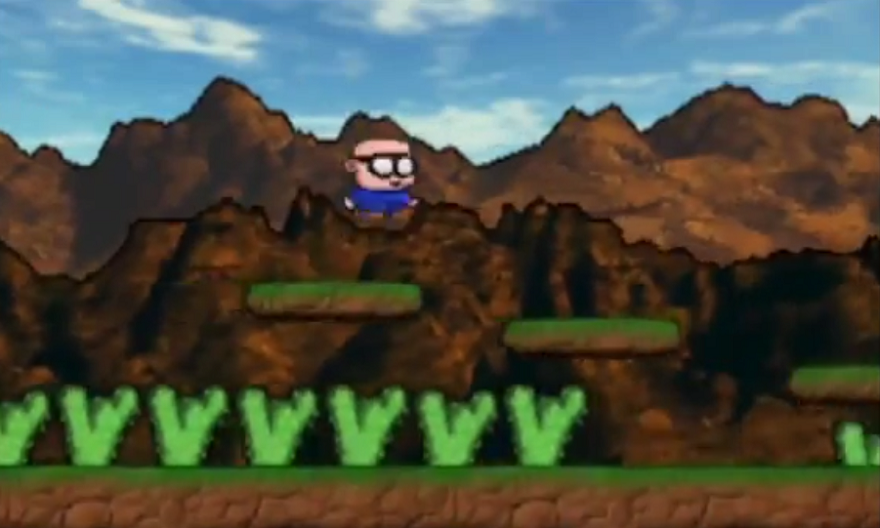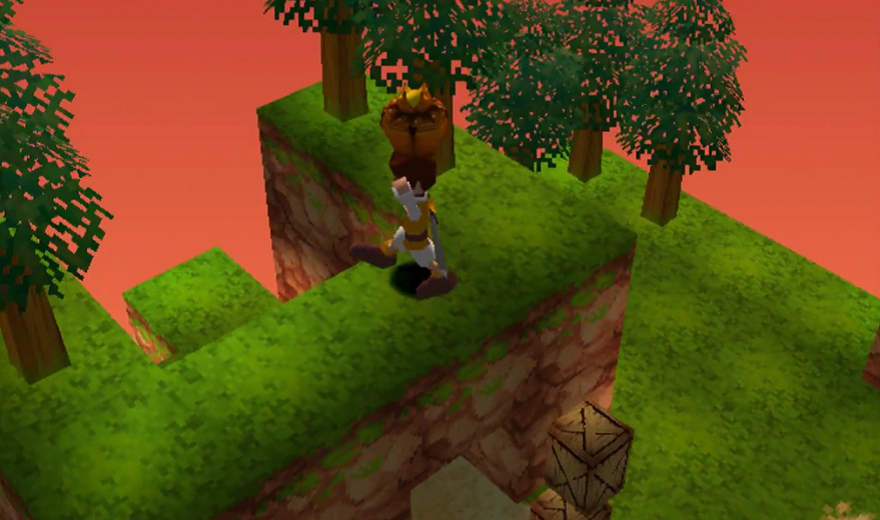A Dog Tale, or the death of mystery

This article is part of PS1 Week, a full week celebrating the original PlayStation. To see the other articles, go here.
///
There’s a young boy on the screen, or perhaps an old man. His glasses, huge opaque circles like welding goggles, dominate his face. They suggest both youth and age at the same time— either the first thick lensed glasses of a myopic child, or the cataract coverings of an half-blind elder. He has no hair, which adds little to the argument either way—his bald head suggesting chronic alopecia more than age. Even the figure’s gender is undefinable, his blue clothing revealing no clear indications of identity. He is squat and plump like a cherub, and, as I look at him, or her, I wonder why we ever assumed he was a child. I suspect that we read it somewhere, perhaps a paragraph in the corner of the magazine the disc came with. That magazine has long since been pulped, and its content stripped from memory, so there is little I can do to confirm that suspicion. In fact, the whole narrative I have in my head starts to collapse the moment I realise that the figure might not be a child.
///
Ira Rainey, like our hero, is bald now. It’s almost twenty years since he created A Dog Tale and its hairless, goggle-eyed protagonist. Looking at the handful of pictures of him scattered around the internet, and on his running blog and Twitter account, there isn’t even a hint that he was once a game developer. Not that I was expecting him to appear like one—in fact, I wasn’t expecting to see him at all. To me, Ira Rainey is a ghost, the words that make up his name and little more. I had, all those years ago, imagined him as a kid, perhaps matching by the appearance of his protagonist, hunched over an old Mac, bashing out code. Or perhaps a malevolent and incompetent trickster, someone in the vein of one of my icons of the time, Futurama’s Robot Devil. Yet here he is, appearing in front of me like a summoned spirit that only requires you to know its name bring it forth. He emerges with little fanfare of course, smiling at the camera in those poorly cropped photos that are unmistakable as profile pictures. One click and I am taken to his Twitter account, where 8,792 tweets await my arrival. One click and I can buy his ebook—208 pages of his journey from “unft to ultramarathon.” One click, and Ira Rainey is alive, and yet, with that one click, something has died.

///
I first played A Dog Tale in 2002, when the UK Official PlayStation Magazine was desperately recycling old content just to fill its free cover discs. It would have been an idle afternoon spent at my friend Chris’ house, cycling through old PlayStation demo discs looking for something to sink some time into. It’s more than likely that he would have been flicking through the magazines, while I clattered through the pile of cases, the PlayStation’s hypnotic startup sound running again and again as discs were shuttled in and out of the console. I can’t say I remember a moment when I started to play A Dog Tale, only a moment when I couldn’t stop. I imagine the tacky muzak and weird hero appealed to our sense of humour instantly (what even is he? And why the hell is he in the desert?), but it was the games’ difficulty that turned our play session into a marathon.
Let me explain: A Dog Tale has one of the worst jumps in the history of games. Either you jump directly up in a straight line, or you jump forward in a perfect triangular parabola. There is no physics system, and certainly none of Mario’s iconic floatiness—just up and down, like a mechanical toy. When combined with cactuses that require you to hit the sharp peak of your jump in order to clear them, the game feels like it is made entirely of hard edges. A classic four life system, a complete lack of sound effects, and a constant loop of ear-bleaching muzak all combine to create a brutally hypnotic cycle of death after death. We sank at least four hours into A Dog Tale that afternoon, and came back again and again with the hope of finishing it. Would there be a dog at the end? Was there a second level? What is the purpose of the keys? Each attempt would be accompanied by the invention of increasingly surreal theories and conversations, from the possibility that the game might have hypnotic powers, to the true identity of Ira Rainey—surely a pseudonym. There was something impenetrable about A Dog Tale, both in its mystery and its difficulty that made it uniquely compelling. There was no hype, no build-up and no information. The entirety of this game and everything we knew about it was contained within that scratched, sticky demo disc in its cracked jewel case.
There it was, half a bulldog sticking out of the edge of the screen tying up the whole narrative in a neat little package
///
If you are interested, A Dog Tale is easy enough to trace now. A quick search of the games’ title and its creators name will bring up videos and images, as well a couple of succinct reviews. You’ll quickly find that from an objective position, there is nothing special about A Dog Tale. It consists of one desert background, one ugly protagonist, 5 keys, 64 bones, a shitload of cactuses and half a dog. You’ll discover that it was released in 1997 and distributed on the free demo discs that came with the UK Official PlayStation Magazine. Perhaps you’ll look long enough to find that it was built on the PlayStation’s commercially available dev kit, the Net Yaroze. From there you can easily uncover that there are more notable games to discuss that came out of the Net Yaroze project, like the RPG Terra Incognita, created by Mitsuru Kamiyama, who would go on to direct Final Fantasy Crystal Chronicles: Ring of Fates. There is also its impact on the UK development scene to consider, with a handful of programmers still working today having entered into development through Net Yaroze projects. This information takes no more than five minutes to acquire.
When A Dog Tale launched in 1997 there was no Google. It would be another year before the search giant would appear, along with its long-standing competitor, MSN search. Ask.com, meanwhile, had just glinted into existence. In 1997, 1.7% of the world’s population was using the internet; by 1998 that had more than doubled to 3.6%. Looking at Ask.com from December of that year, you can get a list of sample questions. 1997 wonders: “Where can I learn about repetitive strain injury?” 1997 inquires: “Where can I learn about gangs?” 1997 can’t help but ask: “Is Madonna’s Mole Real?” It takes me a few seconds to figure out how old Ira Rainey was in 1997. I simply google “Ira Rainey Birth Date” then scroll down to an article posted on “Man vs Fat” in October 2014 that puts him at 45. That means he was 27 when he made A Dog Tale. That’s how old I am now. This is the kind of information that just sits there, not really doing anything, but still very much making its presence felt.

///
In my wandering of the internet I uncovered the beginnings of A Dog Tale speedrun competition on YouTube, where ACRetro’s time of 2:02 is trashed by TheGamesMonster’s 1:03 record-breaking run. TheGamesMonster’s video is notable because he mentions that he emailed Ira Rainey to ask if he made the game, and Ira sent him the original Net Yaroze code. “So if I ever get hold of a Net Yaroze,” says TheGamesMonster, “I can make A Dog Tale level 2.” He laughs a little to himself at this point, then quickly tails off. “Other than that, unfortunately … I cannot do anything quickly.” This video is almost four years old now, and so it can be assumed that this never happened. I imagine the code for A Dog Tale is probably still sitting in some uncleaned corner of TheGamesMonster’s Macbook. He is nowhere to be found, having left YouTube in 2012. His last video is a strangely silent capture of Stone Cold Steve Austin performing his signature Stunner on Kane in WWF 12. It’s only 20 seconds long, but for the last few seconds the camera disappears into the crowd, badly animated fans stepping in front of it to get a better view. They obscure the fight, and we never see if Kane recovers from that brutal knockout blow.
The first time we finished A Dog Tale we didn’t even see the dog. On the tiny cathode-ray tube TV in Chris’ bedroom it was almost impossible to make out the half-creature that lies at the end of the game’s single level. In fact, despite completing the game twice, I was convinced that no dog ever appeared in A Dog Tale. It was only in watching TheGamesMonster’s playthrough that I actually saw the dog for the first time. There it was, half a bulldog sticking out of the edge of the screen tying up the whole narrative in a neat little package. And then, after the dog, Ira’s email address, right there on the screen. It is a strange moment, a moment that slides beneath my memory and undermines it. I have absolutely no recollection of this screen, and more than that, I can’t imagine I wouldn’t have at least thought to send an email to Ira Rainey after spending so long completing his game. “It seems like something we’d do…,” says Chris. I ask him about what he remembers from the ending. “Isn’t there a cage with your dog?” He asks back, “Or is it fuck all?” I push for an answer. “All I remember,” he says “is that it was sudden and disappointing.”
///



